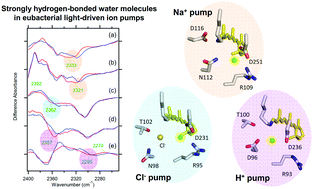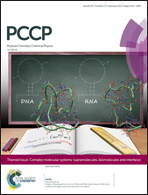Low-temperature FTIR spectroscopy provides evidence for protein-bound water molecules in eubacterial light-driven ion pumps†
Abstract
Light-driven H+, Na+ and Cl− pumps have been found in eubacteria, which convert light energy into a transmembrane electrochemical potential. A recent mutation study revealed asymmetric functional conversion between the two pumps, where successful functional conversions are achieved exclusively when mutagenesis reverses the evolutionary amino acid sequence changes. Although this fact suggests that the essential structural mechanism of an ancestral function is retained even after gaining a new function, questions regarding the essential structural mechanism remain unanswered. Light-induced difference FTIR spectroscopy was used to monitor the presence of strongly hydrogen-bonded water molecules for all eubacterial H+, Na+ and Cl− pumps, including a functionally converted mutant. This fact suggests that the strongly hydrogen-bonded water molecules are maintained for these new functions during evolution, which could be the reason for successful functional conversion from Na+ to H+, and from Cl− to H+ pumps. This also explains the successful conversion of the Cl− to the H+ pump only for eubacteria, but not for archaea. It is concluded that water-containing hydrogen-bonding networks constitute one of the essential structural mechanisms in eubacterial light-driven ion pumps.

- This article is part of the themed collection: Complex molecular systems: supramolecules, biomolecules and interfaces


 Please wait while we load your content...
Please wait while we load your content...